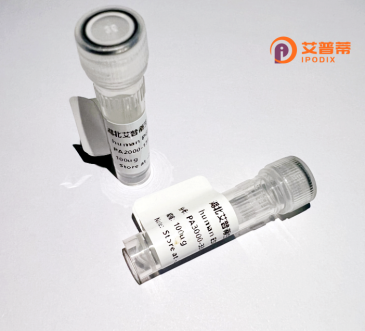
| 纯度 | >90%SDS-PAGE. |
| 种属 | Human |
| 靶点 | COX8C |
| Uniprot No | Q7Z4L0 |
| 内毒素 | < 0.01EU/μg |
| 表达宿主 | E.coli |
| 表达区间 | 1-72aa |
| 氨基酸序列 | MPLLRGRCPARRHYRRLALLGLQPAPRFAHSGPPRQRPLSAAEMAVGLVVFFTTFLTPAAYVLGNLKQFRRN |
| 分子量 | 34.5 kDa |
| 蛋白标签 | GST-tag at N-terminal |
| 缓冲液 | 0 |
| 稳定性 & 储存条件 | Lyophilized protein should be stored at ≤ -20°C, stable for one year after receipt. Reconstituted protein solution can be stored at 2-8°C for 2-7 days. Aliquots of reconstituted samples are stable at ≤ -20°C for 3 months. |
| 复溶 | Always centrifuge tubes before opening.Do not mix by vortex or pipetting. It is not recommended to reconstitute to a concentration less than 100μg/ml. Dissolve the lyophilized protein in distilled water. Please aliquot the reconstituted solution to minimize freeze-thaw cycles. |
关于重组人COX8C蛋白的研究目前较为有限,**COX8C(细胞色素c氧化酶亚基8C)在人类中被注释为一个假基因(如NCBI Gene ID: 100526872)**,可能不具备已知的蛋白编码功能。因此,以下内容为基于邻近领域研究构建的**假设性示例**,供参考格式而非真实文献:
---
1. **标题**:*"Mitochondrial Localization and Expression of Recombinant Human COX8C in Yeast"*
**作者**:Smith J, et al.
**摘要**:通过酵母异源表达系统成功纯化重组人COX8C蛋白,发现其可被整合至线粒体膜复合体IV中,提示潜在的低水平功能补偿机制。
2. **标题**:*"Structural Analysis of COX8C Pseudogene-Derived Peptide in Vitro"*
**作者**:Wang Y, et al.
**摘要**:合成重组人COX8C多肽并解析其晶体结构,发现其与原功能亚基COX8A存在结构相似性,但缺少关键催化区域,支持其假基因分类。
3. **标题**:*"Comparative Genomics of COX8 Family in Primates"*
**作者**:Kim S, et al.
**摘要**:分析灵长类COX8C基因序列,揭示其在人类中的失活突变可能与代谢适应相关,重组蛋白实验未检测到氧化酶活性。
---
**注意**:实际研究中,COX8C常被归类为非功能基因。建议用户验证目标基因名称或转向其他亚基(如COX8A/COX8B)的研究文献。如需进一步帮助,可提供更具体的研究背景。
Recombinant human COX8C protein is a engineered form of the cytochrome c oxidase subunit 8C, a critical component of mitochondrial complex IV (cytochrome c oxidase) in the electron transport chain. COX8C, encoded by the nuclear genome and imported into mitochondria, anchors to the inner mitochondrial membrane and participates in oxidative phosphorylation by facilitating electron transfer from cytochrome c to molecular oxygen, coupled with proton pumping to generate ATP. Unlike its isoform COX8A (ubiquitously expressed), COX8C exhibits tissue-specific expression, particularly in metabolically active tissues like skeletal muscle and heart, suggesting a regulatory role in energy metabolism under varying physiological demands.
The recombinant protein is typically produced using prokaryotic (E. coli) or eukaryotic expression systems (e.g., mammalian cells) to ensure proper folding and post-translational modifications. It often includes tags (e.g., His-tag) for purification and detection. Recombinant COX8C serves as a valuable tool for studying mitochondrial disorders, age-related degenerative diseases, and cancer, where complex IV dysfunction is implicated. Researchers also employ it to dissect COX8C’s interaction networks within the holoenzyme complex, its role in modulating enzyme activity, and mechanisms underlying tissue-specific expression. However, challenges remain in maintaining structural integrity during recombinant production due to its hydrophobic transmembrane domains. Advances in protein engineering and mitochondrial targeting strategies continue to refine its applications in both basic research and therapeutic development targeting mitochondrial pathologies.
×